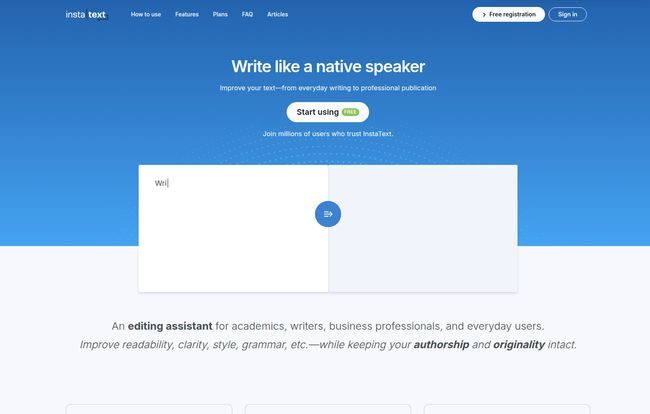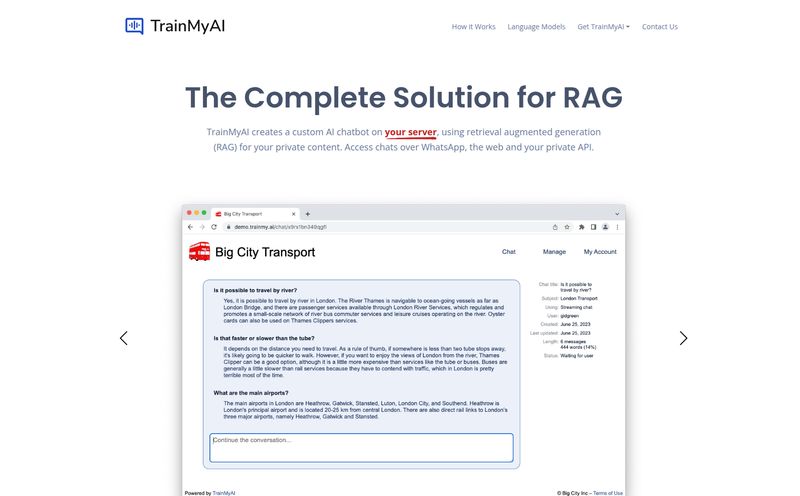We've all been there. Staring at a block of text you’ve just written, knowing in your gut that it's… fine. It’s just fine. The grammar is okay, the spelling checks out, but it lacks that certain something. It doesn't sing. It sounds clunky, maybe a little bit like you’ve just translated it in your head from another language. Even for native speakers, that final polish can be the hardest part.
For years, I've relied on a cocktail of tools and a whole lot of caffeine to get my writing from 'meh' to 'nailed it'. As an SEO and content guy, clarity isn't just nice to have; it's everything. If your message doesn't land, you don't rank, you don't get clicks, you don't make sales. Simple as that. So when I kept hearing whispers about a tool called InstaText, which promised to make you “write like a native speaker,” my curiosity was officially piqued. Another AI writing assistant? The market's pretty crowded. But the testimonials were from academics and professionals, people who live and die by the quality of their prose. So, I decided to take it for a spin.
What Even Is InstaText? (And Why Should You Care?)
Okay, first things first. InstaText is not just another grammar checker. Let's get that out of the way. While it does catch typos and grammatical flubs, that’s not its main gig. Think of it less like a stern grammar teacher with a red pen, and more like a clever co-writer who whispers better ways to phrase things. Its core function is to take your perfectly acceptable sentences and make them better—clearer, more concise, and more natural-sounding.
It uses AI to analyze your text for style, tone, and readability, then offers suggestions to improve it. This goes way beyond what most built-in spell checkers or even some premium tools do. It's about rewriting, not just correcting. And for anyone whose work depends on the written word, from a PhD student trying to get published to a marketer writing ad copy, that's a pretty compelling idea.

Visit InstaText
My First Impressions Putting InstaText to the Test
Signing up was straightforward. The interface is clean, almost minimalist. You get a big, beautiful box to paste your text into. You hit the 'Improve' button, and a few seconds later, you see two versions side-by-side: your original text and InstaText's improved version. The changes are highlighted, so you can see exactly what it did.
I started by throwing a few old blog post drafts at it. The results were… impressive. It tightened up my sentences, swapped out clunky phrases for more elegant ones, and even caught a few awkward repetitions I’d missed. It wasn't just changing words; it was improving the flow. It felt like a human editor had given it a quick, smart pass. The tool also has a Chrome extension and a Word add-in, which is a must for my workflow. I spend half my life in Google Docs, so being able to use it right there is a huge plus.
The Features That Genuinely Make a Difference
After playing around for a bit, a few features really stood out to me as being more than just marketing fluff. These are the things that separate it from the pack.
More Than Just Grammar The Art of Rephrasing
This is the heart of InstaText. I fed it this sentence: "The utilization of this methodology facilitates a more effective data analysis process." It's grammatically correct, but it's corporate jargon nonsense. InstaText spat back: "Using this method makes data analysis more effective." See? Same meaning, half the words, and infinitely more readable. It’s this ability to de-clunkify your writing that I found most valuable. It consistently finds ways to say things more directly.
The Personal Dictionary Taming the AI
Anyone in a niche field knows the pain of an overzealous editor, human or AI, constantly trying to "correct" your industry-specific terms. My world is full of acronyms like CPC, SERP, and CTR. In my experience, most tools stumble over these. InstaText’s Personal Dictionary lets you save words and phrases that you want the AI to ignore. It’s a small feature, but it’s a godsend. It means you can train the tool to understand your context, which saves a ton of time rejecting incorrect suggestions.
Dialect and Tone Control
This is a subtle one, but brilliant. You can switch between US and UK English. As someone who writes for clients on both sides of the pond, this is incredibly useful. No more manually searching for 'organize' vs 'organise' or 'color' vs 'colour'. It just handles it. This attention to detail shows they understand the needs of professional writers.
Who is InstaText Really For?
So, who gets the most out of this? Based on my testing, I see a few key groups:
- Academics and Researchers: The testimonials are full of them for a reason. Academic writing can be dense. InstaText helps make complex ideas more accessible without dumbing them down. A huge win when you're trying to get published.
- Non-Native English Speakers: This is the big one. The tool's whole marketing pitch is about sounding 'native'. It excels at smoothing out the little tells and awkward phrasings that can creep in when English isn't your first language.
- Business Professionals: For anyone writing important emails, reports, or presentations, clarity is king. This tool ensures your message is professional, direct, and easily understood.
- Content Creators and Bloggers: Yep, us too. It's a fantastic final-pass tool to tighten up your articles before you hit publish. It helps turn good writing into great writing.
The Not-So-Perfect Bits: A Dose of Reality
Okay, it's not all sunshine and perfectly crafted sentences. No tool is perfect, and it's important to be honest about the downsides. Some might argue that relying too much on a tool like this could make your own writing muscles a bit weak over time. I get that. If you're a student trying to learn the fundamentals, maybe you shouldn't use this as a crutch.
The other danger is losing your unique voice. If you blindly accept every single suggestion, your writing might start to sound a little… generic. The key is to use it as a collaborator, not a dictator. Review the suggestions. Does the new phrasing still sound like you? Sometimes the original, slightly-imperfect sentence has more personality. It’s a tool for improvement, not replacement. You're still the author.
Let's Talk Money: Is the InstaText Pricing Worth It?
This is always the million-dollar question, or in this case, the €120-a-year question. InstaText operates on a subscription model. Here’s a quick breakdown:
| Plan | Billing Cycle | Price | Notes |
|---|---|---|---|
| InstaText One Premium | Monthly | €24.99 / month | Good for short-term projects. |
| InstaText One Premium | Yearly | €9.99 / month (billed as €119.88 annually) | Saves 60%. This is the best value by far. |
So, is it worth it? Honestly, if you're a casual writer, the monthly price is a bit steep. But for anyone who writes for a living or for their studies—academics, marketers, business owners, serious bloggers—the yearly plan is a no-brainer. Think about it. That's about the cost of two fancy coffees a month. If it saves you even just a couple of hours of editing time or helps you land one client or get one paper accepted, it has paid for itself many times over. Its great for academics, business pros and students alike.
My Final Verdict: Is InstaText a Keeper?
After a couple of weeks of using InstaText on everything from client emails to this very blog post, I can say it's earned a permanent spot in my digital toolbox. It's fast, smart, and genuinely useful.
It's not going to write for you. It's not going to magically give you brilliant ideas. But it will take your brilliant ideas and make sure they are communicated with the clarity and professionalism they deserve. It's the final 10% polish that often makes 90% of the difference. It helps you get out of your own head and see your writing from a reader's perspective, and that, my friends, is priceless.
Frequently Asked Questions About InstaText
- What is InstaText best used for?
- InstaText is best for improving the clarity, style, and flow of your writing. It's ideal for professionals, academics, and non-native English speakers who want to ensure their text is clear, concise, and sounds natural.
- Can InstaText replace a human editor?
- For a final polish and style improvement, it's fantastic. However, for in-depth structural editing, fact-checking, or content strategy on a major project like a book, a human editor is still irreplaceable. Think of InstaText as your day-to-day editing assistant.
- How is InstaText different from Grammarly?
- While both tools check for errors, Grammarly focuses more heavily on grammar, punctuation, and spelling correction. InstaText's primary strength is rewriting and rephrasing entire sentences to improve overall readability and style, helping your text flow better.
- Is there a free version of InstaText?
- InstaText operates on a premium subscription model. While they may offer a trial to test the functionality, full, unlimited access to all its features requires a paid plan. The power of the tool really comes with the unlimited use offered in the premium tiers.
- Does InstaText work on all websites?
- With the browser extension (available for Chrome and other major browsers), InstaText works on over 20 popular platforms, including Google Docs, Gmail, Outlook, Slack, and more. It also has a dedicated Microsoft Word add-in.
- Is InstaText worth the price?
- For serious writers, the yearly subscription offers tremendous value. If your career or academic success depends on high-quality writing, the time saved and the improvement in quality can easily justify the cost. For casual users, it might be a bigger decision.
Reference and Sources
- InstaText Official Website
- InstaText Plans and Pricing
- Harvard Business Review - Good Writing is Good Business



